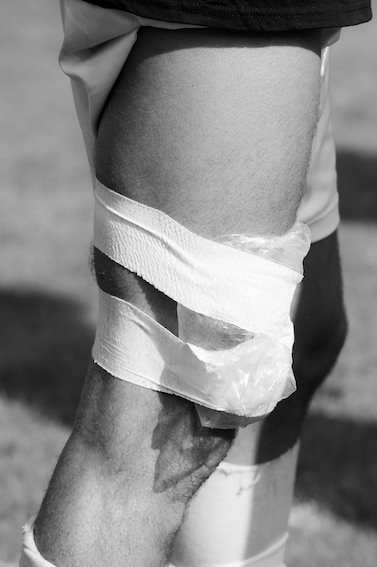Should we compress the injured area?
In the 2014 AFL season 25% of new injuries sustained were attributed to lower limb muscle strains. A combination of rest, ice, compression, and elevation (RICE) is seen as the typical management for an acute muscle injury. The goal of initial injury management is to reduce bleeding, swelling and minimize inflammation. Active muscle degeneration and inflammation occur in the first few days post-injury, with the inflammatory stage of healing peaking at approximately 48 hours. Elastic bandages are generally recommended to compress the affected area immediately after injury.

What does the evidence show?
Research completed back in 1987 showed that a moderate compression bandage could reduce muscular blood flow by approximately 50% at rest and post running in healthy individuals. The participants in this study had not sustained a muscle strain injury, and the effects of compression on an injured population surprisingly have not been established since.
So what should we do if we encounter a muscle strain injury?
According to a panel of experts early ice and compression were rated between useful to essential according to the current best-available evidence.
RICE-R
R- Rest
I- Ice
C- Compression
E- Elevation
R- Referral: for accurate diagnosis and management plan
No HARM
H- Heat
A- Alcohol
R- Running
M- Massage
Also remember that stretching into pain and the use of anti-inflammatory medications can have negative effects on tissue healing in these early stages of recovery and should be avoided until cleared by your treating Physiotherapist or Sports Doctor.
Daniel is the team physiotherapist at Claremont Football Club along with Anthony McEvoy, and is a guest lecturer for Sports Medicine Australia. He is happy to answer any questions you may have about your injuries and available for consultations at our Cottesloe and Claremont clinics.
Huard, J., Li, Y., & Fu, F. H. (2002). Muscle injuries and repair: current trends in research. Journal of Bone & Joint Surgery – American Volume., 84-A(5), 822-832.
Noonan, T. J., & Garrett Jr, W. E. (1999). Muscle strain injury: diagnosis and treatment. Journal of the American Academy of Orthopaedic Surgeons, 7(4), 262-269.
Orchard, J., Seward, H., & Orchard, J. (2014). 2014 AFL Injury Report.
Orchard, J., Best, T., Mueller-Wohlfahrt, H., Hunter, G., Hamilton, B., Webborn, N., et al. (2008). The early management of muscle strains in the elite athlete: best practice in a world with limited evidence basis. British Journal or Sports Medicine, 42, 158-159.
Thorsson, O., Hemdal, B., Lilja, B., & Westlin, N. (1987). The effect of external pressure on intramuscular blood flow at rest and after running. Medicine and Science in Sports and Exercise, 19(5), 469-473.
